Researchers have discovered a type of white blood cell in the lungs, called senescent macrophages, that promote tumor growth.



Some mutations were like a tax rebate and raised the propensity of TAR to adopt its biologically active structures, while other modifications raised the tax and decreased the odds that TAR would adopt a biologically active structure.
Hidden mechanism may lead to new drugs
“What we found was a hidden mechanism for controlling the activity of a molecule in a cell,” says Al-Hashimi. By altering the propensity of TAR to form biologically active states—by changing the tax rate—the researchers could fine-tune the molecule’s activity in cells.

Just as space holds infinite mysteries, when we zoom in at the level of biomolecules (one trillion times smaller than a meter), there is still so much to learn.
Rensselaer Polytechnic Institute’s Catherine Royer is dedicated to understanding the conformational landscapes of biomolecules and how they modulate cell function. When biomolecules receive certain inputs, it can cause the atoms to rearrange and the biomolecule to change shape. This change in shape affects their function in cells, so understanding conformational dynamics is critical for drug development.
In research recently published in the Proceedings of the National Academy of Sciences, Royer and her team examined the conformational dynamics of a human transfer ribonucleic acid (tRNA) under high hydrostatic pressure. The high pressure led to an increased population of the tRNA-excited states that normally exist at very low levels, allowing new insights into tRNA function.
Join top executives in San Francisco on July 11–12, to hear how leaders are integrating and optimizing AI investments for success. Learn More
ElevenLabs, a year-old AI startup from former Google and Palantir employees that is focused on creating new text-to-speech and voice cloning tools, has raised $19 million in a series A round co-led by Andreessen Horowitz (a16z), former Github CEO Nat Friedman and former Apple AI leader Daniel Gross, with additional participation from Credo Ventures, Concept Ventures and an array of strategic angel investors including Instagram’s co-founder Mike Krieger, Oculus VR co-founder Brendan Iribe and many others.
In addition, Andreessen Horowitz is joining ElevenLabs’ board, citing the late Martin Luther King Jr.’s “I Have a Dream” speech in its blog post on the news, as one of the examples of how the human “voice carries not only our ideas, but also the most profound emotions and connections.”

A recent study published in The American Journal of Clinical Nutrition determined whether marine omega-3 fatty acid (FA) consumption increases atrial fibrillation (AF) risk among United States military veterans.
Study: Dietary ω-3 fatty acids and the incidence of atrial fibrillation in the Million Veteran Program. Image Credit: Natali _ Mis / Shutterstock.com.

Researchers have created synthetic human embryos using stem cells, according to media reports. Remarkably, these embryos have reportedly been created from embryonic stem cells, meaning they do not require sperm and ova.
This development, widely described as a breakthrough that could help scientists learn more about human development and genetic disorders, was revealed this week in Boston at the annual meeting of the International Society for Stem Cell Research.
The research, announced by Professor Magdalena Żernicka-Goetz of the University of Cambridge and the California Institute of Technology, has not yet been published in a peer-reviewed journal. But Żernicka-Goetz told the meeting these human-like embryos had been made by reprogramming human embryonic stem cells.

Researchers have discovered that senescent pigment cells in skin moles can stimulate robust hair growth, challenging the belief that these cells impede regeneration. The study showed that molecules osteopontin and CD44 play a key role in this process, potentially opening new avenues for therapies for common hair loss conditions.
The process by which aged, or senescent, pigment-making cells in the skin cause significant growth of hair inside skin moles, called nevi, has been identified by a research team led by the University of California, Irvine. The discovery may offer a road map for an entirely new generation of molecular therapies for androgenetic alopecia, a common form of hair loss in both women and men.
The study, published on June 21 in the journal Nature, describes the essential role that the osteopontin and CD44 molecules play in activating hair growth inside hairy skin nevi. These skin nevi accumulate particularly large numbers of senescent pigment cells and yet display very robust hair growth.

Loughborough University scientists are the first to demonstrate that a terahertz wave camera can capture 3D images of microscopic items hidden inside small objects.
Lead researcher Dr. Luana Olivieri says though the research is in the early stages, the team’s latest study could have “major implications for a range of fields with relevance in cancer screenings, security, and materials research.”
The research, which is in collaboration with Professor Marco Peccianti, Dr. Luke Peters, Dr. Juan S. Totero and a team of experts from the Emergent Photonics Research Center (EPicX), demonstrates that terahertz waves can be used to locate and recognize embedded objects and features, such as cracks and bubbles, in microscopic three-dimensional space. The study has been published in the journal ACS Photonics and is featured on the front cover of the latest issue, published today (June 21).

A team of chemists and material scientists at the University of Tokyo has developed a new class of interlocking supramolecular systems by combining metal-organic frameworks with rotaxanes. In their study, reported in the journal Nature Communications, the group combined the two structures and found possible uses for the results.
Metal-organic frameworks (MOFs) are compounds made using metal ions in such a way as to create one-, two-, or three-dimensional structures. The resultant ligands are known in the chemistry world as linkers or struts. They are typically used to make products such as sensing equipment, machines that store energy or those that separate and purify liquids. They have also been used for biological imaging and drug delivery.
Rotaxanes are molecular structures that are interlocked in dumbbell shapes. They are created by threading cyclic molecules into other molecules and then applying end caps. They are typically used as molecular switches in electronics devices, and sometimes as shuttles. In this new effort, the research team developed a way to connect the two types of compounds to create new kinds of interlocking structures.

Cells in the human body, the building blocks of life, are arranged in a precise way. That’s necessary because pathways and spaces provide a means for cells to communicate, collaborate and function within the specific tissue or organ. Changes in cell arrangement can lead to uncontrolled cell growth, cell death and diseases, including cancer.
Scientists at the Mayo Clinic Center for Individualized Medicine and Mayo Clinic Comprehensive Cancer Center have developed an artificial intelligence method, called Spatially Informed Artificial Intelligence (SPIN-AI). This new deep-learning technique can analyze the genetic information of individual cells to reconstruct the precise layout of the cells in a tissue, without preexisting knowledge of how the cells are organized.
The new study detailing SPIN-AI is published in Biomolecules.